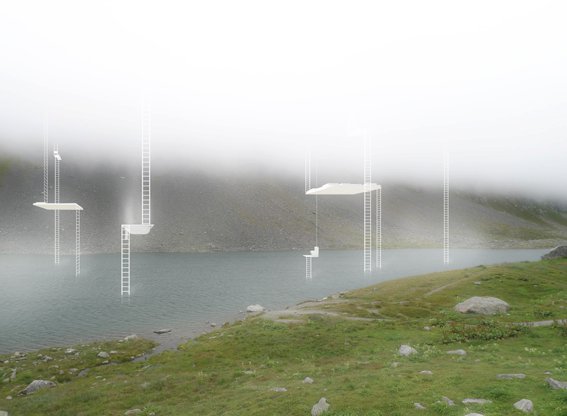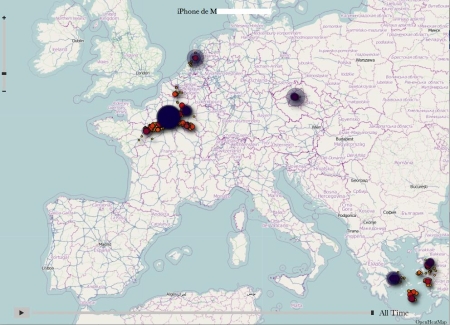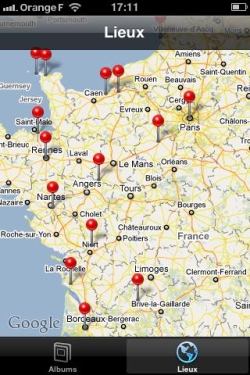Thursday, April 21. 2011
Very nice edited picture by Philippe Rahm architectes on Rahm's Facebook account. It's about a publication in Hochparterre, a swiss magazine. I haven't read the article yet... but the picture describes a sort of climatically variable, imaginary "landscaped" architecture according to what I speculate. Architecture as variable landscape. I like it a lot.
To understand why the different "functions" are at different level and why you would need to use ladders to get there, you should check this project.

Via MIT Technology Review
-----
An experimental system would tighten the limits on information provided to websites.
By Erica Naone
 |
| Credit: iStockphoto |
Today, many websites ask users to take a devil's deal: share personal information in exchange for receiving useful personalized services. New research from Microsoft, which will be presented at the IEEE Symposium on Security and Privacy in May, suggests the development of a Web browser and associated protocols that could strengthen the user's hand in this exchange. Called RePriv, the system mines a user's behavior via a Web browser but controls how the resulting information is released to websites that want to offer personalized services, such as a shopping site that automatically knows users' interests.
"The browser knows more about the user's behavior than any individual site," says Ben Livshits, a researcher at Microsoft who was involved with the work. He and colleagues realized that the browser could therefore offer a better way to track user behavior, while it also protects the information that is collected, because users won't have to give away as much of their data to every site they visit.
The RePriv browser tracks a user's behavior to identify a list of his or her top interests, as well as the level of attention devoted to each. When the user visits a site that wants to offer personalization, a pop-up window will describe the type of information the site is asking for and give the user the option of allowing the exchange or not. Whatever the user decides, the site doesn't get specific information about what the user has been doing—instead, it sees the interest information RePriv has collected.
Livshits explains that a news site could use RePriv to personalize a user's view of the front page. The researchers built a demonstration based on the New York Times website. It reorders the home page to reflect the user's top interests, also taking into account data collected from social sites such as Digg that suggests which stories are most popular within different categories.
Livshits admits that RePriv still gives sites some data about users. But he maintains that the user remains aware and in control. He adds that cookies and other existing tracking techniques sites already collect far more user data than RePriv supplies.
The researchers also developed a way for third parties to extend RePriv's capabilities. They built a demonstration browser extension that tracks a user's interactions with Netflix to collect more detailed data about that person's movie preferences. The extension could be used by a site such as Fandango to personalize the movie information it presents—again, with user permission.
"There is a clear tension between privacy and personalized technologies, including recommendations and targeted ads," says Elie Bursztein, a researcher at the Stanford Security Laboratory, who is developing an extension for the Chrome Web browser that enables more private browsing. "Putting the user in control by moving personalization into the browser offers a new way forward," he says.
"In the medium term, RePriv could provide an attractive interface for service providers that will dissuade them from taking more abusive approaches to customization," says Ari Juels, chief scientist and director of RSA Laboratories, a corporate research center.
Juels says RePriv is generally well engineered and well thought out, but he worries that the tool goes against "the general migration of data and functionality to the cloud." Many services, such as Facebook, now store information in the cloud, and RePriv wouldn't be able to get at data there—an omission that could hobble the system, he points out.
Juels is also concerned that most people would be permissive about the information they allow RePriv to release, and he believes many sites would exploit this. And he points out that websites with a substantial competitive advantage in the huge consumer-preference databases they maintain would likely resist such technology. "RePriv levels the playing field," he says. "This may be good for privacy, but it will leave service providers hungry." Therefore, he thinks, big players will be reluctant to cooperate with a system like this.
Livshits argues that some companies could use these characteristics of RePriv to their advantage. He says the system could appeal to new services, which struggle to give users a personalized experience the first time they visit a site. And larger sites might welcome the opportunity to get user data from across a person's browsing experience, rather than only from when the user visits their site. Livshits believes they might be willing to use the system and protect user privacy in exchange.
Copyright Technology Review 2011.
Via Libération
-----
par Alexandre Hervaud

Capture Ecrans
Dire où l’on se trouve en permanence via son smartphone, c’est simple comme bonjour : on peut le déclamer à qui ça intéresse (indice : personne) via les versions mobiles des réseaux sociaux type Facebook ou Twitter, ou check-iné comme un fou sur les appli spécifiques de géolocalisation comme Foursquare. Mais il y a un autre moyen, d’autant plus simple qu’il est automatique : avoir un iPhone et permettre sans le savoir à Apple de pister nos moindres déplacements.
La découverte est signée Alasdair Allan et Pete Warden, deux spécialistes qui l’ont annoncé aujourd’hui à la conférence Where 2.0 après l’avoir explicité sur le site Radar. Leur trouvaille peut être résumée ainsi : les iPhone et iPad 3G fonctionnant sous le système d’exploitation iOS4 (disponible depuis juin 2010) enregistrent régulièrement la localisation des produits dans un fichier caché, dont le contenu est restauré à chaque sauvegarde ou migration d’appareil.
Concrètement, d’après Radar, les localisations sont stockées dans un fichier appelé consolidated.db, avec coordonnées géographiques évoluant en fonction de la date d’enregistrement. La chose n’est pas toujours archi précise, triangularisation oblige, mais un test auprès des collègues de Liberation.fr montre le genre de données ainsi enregistrées :

Un logiciel baptisé iPhone Tracker est disponible pour lire à son tour ce genre de traces. En mouvement (soit en faisant évoluer la chronologie), ça donne ça :
Washington DC to New York from Alasdair Allan on Vimeo.

Radar précise qu’à ce stade, rien ne prouve que ces données puissent échapper au contrôle de l’utilisateur (comprendre : être envoyées via le Net à des serveurs cachés contrôlés par de maléfiques Big Brother en puissance suivant la moindre de nos traces). De même, l’existence même de ce type d’informations n’est pas en soi une nouvelle : les opérateurs téléphoniques en disposent et peuvent les transmettre aux autorités dans certaines circonstances (enquêtes, etc.), mais uniquement sur demande en bonne et due forme (mandat, par exemple). Le problème ici soulevé est que le fichier en question n’est pas du tout crypté, donc facilement accessible en cas de vol ou d’emprunt de téléphone, par exemple. Des fonctionnalités permises par l’iOS4, comme la classification automatiques des photos prises par l’iPhone en fonction du lieu de la prise de vue (cf capture à droite), peuvent éventuellement constituer une piste d’explication quant à la présence d’un tel fichier dans le téléphone.
Parmi les pistes suggérées par Radar pour éviter ce genre de désagrément, on peut citer l’option « Encrypt iPhone Backup » accessibles via les paramètres d’iTunes une fois l’appareil connecté à l’ordinateur. Alasdair Allan et Pete Warden expliquent en détail leur trouvaille dans la vidéo ci-dessous (en anglais, 20 minutes) :
Pour la petite histoire, Peter Warden a travaillé durant cinq ans pour Apple (mais jamais directement sur l’avancée de l’iPhone), avant de quitter l’entreprise « en bons termes » il y a trois ans. Sur la page permettant de télécharger iPhone Tracker, qu’ils ont conçus eux-même, les deux geeks semblent presque déçus de leur découverte : « on est tous les deux de grands fans des produits Apple, et on ne prend vraiment aucun plaisir à mettre en avant ce problème ».
Wednesday, April 20. 2011
Via @joelvacheron
-----
Documentary made after William Foote Whyte's seminal book "Street Corner Society".
Friday, April 15. 2011
Via dpr-barcelona
-----

The relationship between architecture and photography is so old as both disciplines. While Anne Elisabeth Toft asks “Is it possible to capture, translate and transmit architectural experience via representations?” we can recall to the most recent work of the filmmaker and artist Wim Wenders, called Places, strange and quiet which is based on a fascinating series of large-scale photographs taken in countries around the world from Salvador, Brazil; Palermo, Italy; Onomichi, Japan to Berlin, Germany; Brisbane, Australia, Armenia and the United States. Wenders pointed on his latest publication:
When you travel a lot, and when you love to just wander around and get lost, you can end up in the strangest spots. I have a huge attraction to places. Already when I look at a map, the names of mountains, villages, rivers, lakes or landscape formations excite me, as long as I don’t know them and have never been there … I seem to have sharpened my sense of place for things that are out of place. Everybody turns right, because that’s where it’s interesting, I turn left where there is nothing! And sure enough, I soon stand in front of my sort of place. I don’t know, it must be some sort of inbuilt radar that often directs me to places that are strangely quiet, or quietly strange.
But what about photographing not buildings, but landscape, urban voids and ruins? Can we talk about the same relationship as in between architecture and photography?


Most of Wim Wenders‘ photographs are created during his personal travels and while location-scouting for his films. From his iconic images of exteriors and buildings to his panoramic depictions of towns and landscapes, it’s not strange to find some of his movies accompanied by photo exhibitions and publications such as The Heart is a Sleeping Beauty as part of The Million Dollar Hotel or his 1999 film Buena Vista Social Club which was featured with the companion book by Wim Wenders and Donata Wenders.
Wim Wenders was a painter before he started working on film and photography, and he talked about this in an interview with Michael Coles:
I was heavily influenced by the so-called New American Underground. A lot of American painters made movies in the mid to late ’60s, Warhol being the most famous one. There was a whole retrospective traveling through Europe at the time. I saw these films in ’66 or ’67, and that was very important for me. I wrote about them, too. I wrote about Michael Snow especially, and a film that he had made called Wavelength (1967). It was the first article I wrote. Wavelength was a painter’s film. It was actually only one shot, a painstakingly slow zoom across a room toward the windows. Day and night were passing. Nothing much happened. It was very painterly. My first films were basically landscape paintings, except that they were shot with a movie camera. I never moved the frame. Nothing ever happened in them. Each scene lasted as long as a 16-millimeter daylight reel, which was about four minutes. There was no editing involved, other than attaching one reel to the other.
Wenders photographic work is obviously very cinematic. His approach to catch the right moment and the right place, his sensibility to transmit with images what a urban place can mean and the way he freezes different urban context is widely poetic and full of literary references.

Wenders points that he doesn’t think that any photographer has anything else in mind than that particular moment he is capturing. This is the main guideline of the photo-work of the exhibition that will take place at the Haunch of Venison, in London.
“…but a story,
from that story came a script,
and from the script a film -
which never wanted to conceal
that it might just as well have become a song:
a song about a different America
beyond that great big Dream,
where truly
everyone
is
equal.”
- Wim Wenders


As he said, “discovering the story that a place wants to tell. That’s my main concern, my attitude. Listening to the place. For me, taking a picture is more an act of listening, so to speak, than of seeing.” Now, the questions hidden in every picture are always the same:
What happened to that place? What happened to those people? How does this house or this street or this landscape look now, 10 or 30 years later?
—–
Image credits:
[1] Ferris Wheel, Armenia 2008, C-Print, 151,3 x 348 cm © Wenders Images GbR
[2] Open Air Screen, Palermo 2007, C-Print, 186×213 cm © Wenders Images GbR
[3] The Red Bench, Onomichi, 2005, C-Print, 186 x 200,6 cm © Wenders Images GbR
[4] Cemetery in the City, Tokyo 2008, C-Print, 132×133 cm © Wenders Images GbR
[5] Moscow Backyard, Moskau 2006, C-Print, 125×139 cm © Wenders Images GbR
[6] Ferris Wheel (Reverse Angle), Armenia 2008, C-Print, 151,3 x 348 cm © Wenders Images GbR
The book Places, strange and quiet has been published by Hatje Cantz Verlag. More info at their web-site
|











